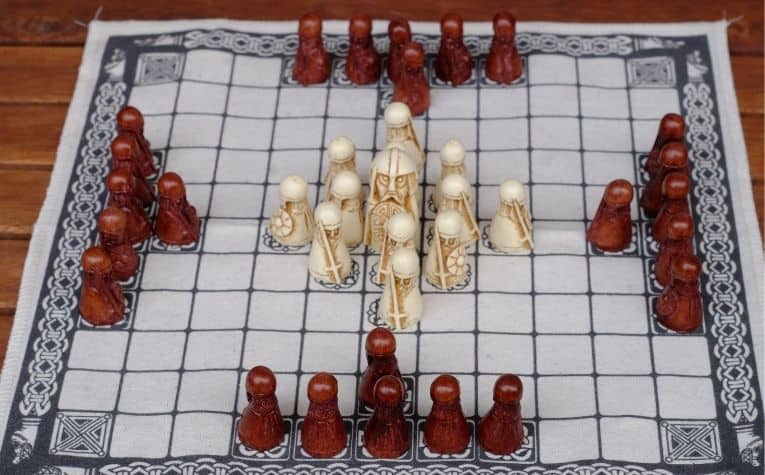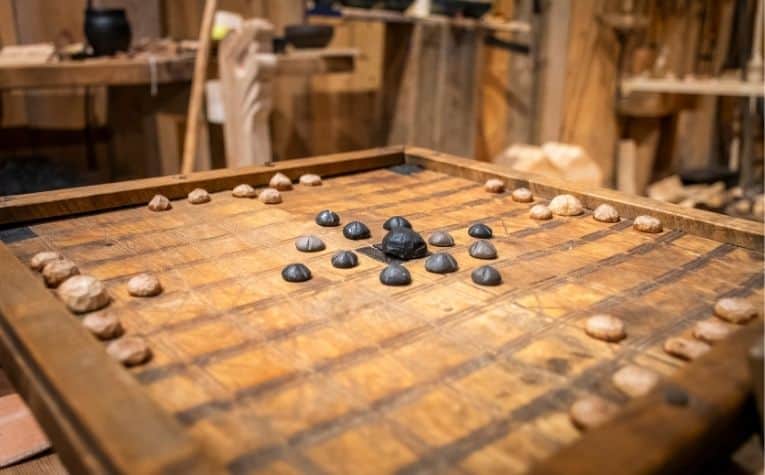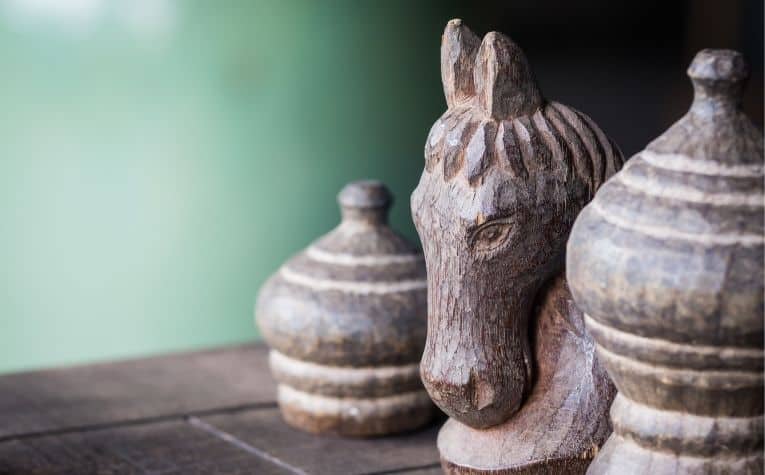Games and sports were a big part of Viking culture in the Middle Ages in Scandinavia.
According to archaeological evidence and saga literature from the time period, the Vikings loved outdoor sporting competitions as well as board games.
In fact, they were considered a regular pastime activity. But did the Vikings also play chess?
The Vikings played a type of chess “called Hnefatafl,” which means game or king board, where “king” refers to a particular piece in the game.
This board game was like modern-day chess, yet some believed that it mimicked a Viking raid, and the object of the game was interpreted as defeating the opposing king.
The pieces of the game, the strategy involved, and the regularity with which the Vikings played Hnefatafl reflects the values and uniqueness of their ancient Scandinavian culture.
Read on to learn more about Hnefatafl, as well as other games the Vikings played.
Many people find the Vikings’ way of life fascinating. See What Did the Vikings Drink Out Of? to learn more.

What Is Hnefatafl?
Hnefatafl dates back to over 1600 years. [1] Interest in such games has been renewed in recent years.
In 2007 Hnefatafl enthusiasts created the Fetlar Hnefatafl Panel to promote the game around the globe. [2]
The game was played in North-West Europe and was referred to as “Viking Chess” because it was based on the historical records of the board game from the Viking era. [3]
This game is strategic, like modern-day chess. Today, people can even play as on online multiplayer or a single player. [4]
Origin of Hnefatafi
Historians believed that Hnefatafl originated from a Roman game called “Ludus Latrunculorum.”
The game is mentioned in classic literary works like Voluspa, Frithiof’s Saga, and Hervor & Heidrek.
In addition to Hnefatafl being considered a recreational activity in the Viking Era, some archeologists suspect that the game was also seen as a religious symbol and perhaps a metaphor for military strategy.
Unfortunately, there is no surviving record of rules that the Vikings used for the game.
Modern-day versions of Hnefarafl use the same rules as Copenhagen Ruleset, which is based on rules as they are traditional understood.
In 1732, Carl Linnaeus, a Swedish botanist, came across a game called “Tablut” on his travels, that closely resembled Hnefatafl.
He wrote the game rules in Latin and even drew pictures of the board and its pieces.
In 1952, Harold Murray, a chess historian wrote the book Board Games Other Than Chess.
Murray reflected on Linnaeus’ account of Tablut and determined that the 18th-century Swedish botanist was correct—the game very similar to Hnefatafl.
This raises the question of the games having a similar origin whether in Scandinavia or in the Mediterranean region.
Did the Vikings write? See Did the Vikings Have a Written Language? to learn more.

How Was Hnefatafi Played?
Hnefatafl involves a 24-piece army, which strategically attacks the opposing pieces with the goal of defeating them and being declared the sole victor.
Players need to ensure the opposition surrenders, in part, by eliminating all possible escape routes in order to contain, trap, and conquer.
Hnefatafl is played on a board with squares. The center of the board has special markings that are strategic to to the gameplay.
Certain game boards in Norway were squared at 13 x 13 inches (33.02 centimeters).
Some were double-sided. A few boards were scratched with rock slices or marked out with charcoal.
The rules of the game involved the king moving first.
The opponent wins by trapping the king.
The king is only trapped when surrounded by four pieces at the center square.
However, he can’t be trapped when he gets to the edge.
The pieces on the board move in straight lines like the rook in chess. A player may move a piece through a number of squares if no other pieces are blocking the way.
The player cannot make a piece pass or skip over another piece.
A player may take two opposing pieces at one time if the movement adheres to the rules of the game.
Did the Vikings have markings on their bodies? See How the Vikings Got Tattoos (and Why)? to learn more.

What Other Games Did the Vikings Play?
In addition to Hnefatafl, the Vikings also played other games. Below is a brief overview of other games played in the Viking era.
Tabula
Tabula, also called Duodecim Scripta, is a Roman game popular in Scandinavia and Germany.
The game involves multiple wooden boards, and historians have discovered these types of boards from the Viking Age in Denmark. [5]
The board contained 24 rectangles that were aligned in two parallel rows of 12.
It resembles a Backgammon board; the difference is that the former has lines dividing the board into sections on either side instead of points.
Each player has 15 pieces with contrasting colors, and three six-sided dice show the moves.
Playing Tabula involves placing the pieces on the near-left side of the player and all around the board in an anti-clockwise direction.
The players take turns to roll the dice and move the pieces, like in chess.
A throw of the dice gives the player three moves.
That means the player can choose to move three pieces once each, move a single piece three times, or move one piece twice and another once.
An opposing piece can’t move if a player has two men at the same spot. In case a piece is captured, it’s removed from the board, and needs to start over.
Halatafi
Halatafi is another game board. It consists of a board with holes in place of squares, with the corner and center positions marked clearly.
This game resembles modern solitaire with the two notches on the board, indicating a division between the red and white pieces.
The board has 49 holes marked and 22 identical men set up on the board.
The corner and center holes are empty.
A player can move the pieces forward, diagonally, or sideways along the lines, but can never move backward.
There is an option to jump over a piece if there’s an empty hole.
White starts the game by placing a piece into the center hole, while the red takes over by jumping over the white one, and the game continues until a player on either side is left with less than five pieces.
Nine Men’s Morris or Merels
Although Merels was popular in ancient Egypt, it’s referred to as the game on the other side of the board in the Viking context.
Boards found in this era have Hnefatafl on one side and Merels on the other.
The game was also discovered in lumps of rock, ship timber, benches, tiles, and loose boards.
Nine Men’s Morris is a simple board game that involves bones or stones.
Historians believe that a die may have been used in the Viking version of this game. [6]
Dice Games
Dice in the Viking age were made from antlers, walrus ivory and bone.
There are reports of a cubic dice that was discovered in Viking Dublin with a different number combination.
Some archeologists think that the dice that were found could have also been used for Tabula. [7]
Interestingly, their dice were 20-sided and engraved with Greek characters from Egypt.
Historians believe that these dice were not always used for games; they may have been representing an ancient god and used to assist the dice thrower with the power of divination.
Scandinavian games
The evidence reveals that the Vikings enjoyed playing board games in the Middle Ages, especially Hnefatfil.
References
[1] https://www.norseamerica.com/Hnefatafl.html
[2] https://www.fetlar.org/hnefatafl
[3] https://www.atlasobscura.com/articles/what-is-hnefatafl-viking-board-game
[4] https://www.classicgame.com/game/Hnefatafl
[5] https://regia.org/research/misc/games.htm
[6] https://en.wikipedia.org/wiki/Nine_men%27s_morris
[7] https://www.metmuseum.org/art/collection/search/551072
Also see:
- Hurstwic.com: Understanding the Viking Era
- NorseAmerica: The Viking Game Hnefatafl
- Metmuseum: Twenty-sided die (icosahedron) with faces inscribed with Greek letters
- Ancientgames.org: Playboard Games of the Ancient Times
- Atlas Obscura: The Board Game at the Heart of Viking Culture
- Wikipedia: Nine men’s morris
- Regia: Games of the Viking and Anglo-Saxon Age
- Hnefatafl: The History of Hnefatafl
